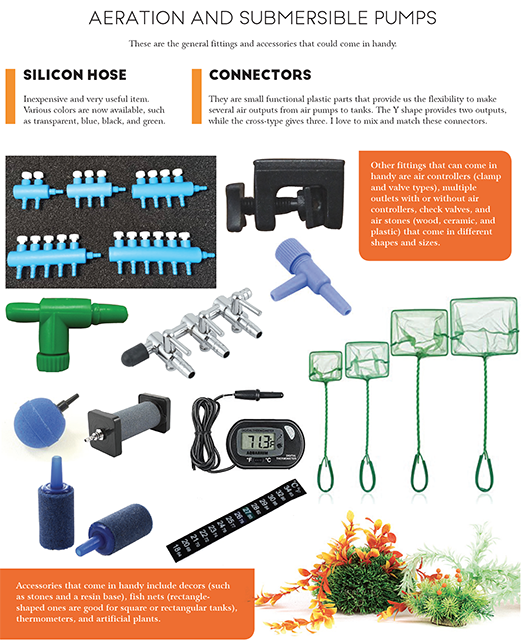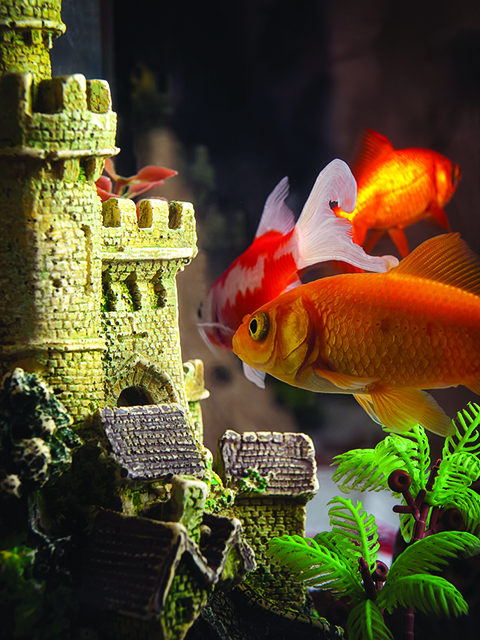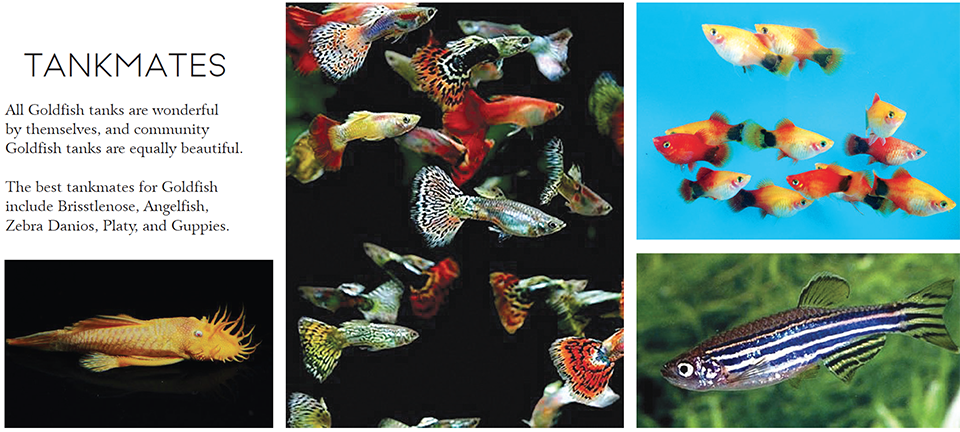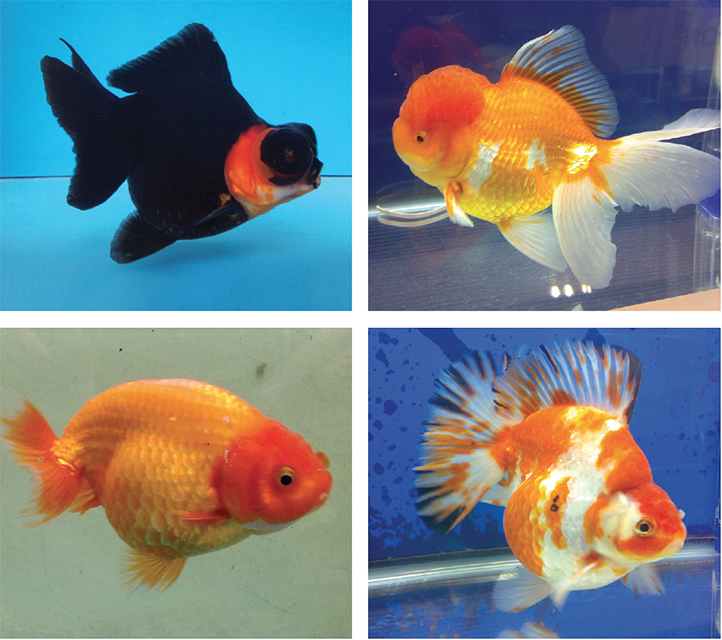Photos by MANUEL YAP
The previous times, the basic setup for taking care of Goldfish at home was tackled, focusing on filter media, tanks, ponds, and pumps. Here’s more information for one to be able to provide the best care for their Goldfish.
TANK STAND
The most inexpensive commercially available tank stands are made of metal painted in black. They are designed to house two tanks. One tank is located at the bottom and another on top. This is a good idea, since the weight of the tank below stabilizes the whole setup. Some use the space for a filter sump.
The more expensive metal stands have better design and paint quality. They normally use powder coat paints instead of lacquer or enamel paints.

LIGHTING
Aquarium lights are now more creative than ever before. They have been abundantly popular in the previous years, and they are still available today as the pink fluorescent lights that use starters and ballast. Marine set-ups provide more light availability, such as actinic and white lights with different Kelvin intensity. The age of the LED bulbs has provided excitement to tanks.
They are reasonable in price but very durable. They are also flexible in design and color. They come in strips, tubes, and T5 types. Dancing multiple colored LEDs are quite popular, too. I use the LED T5 type (“Lite plus”) white light. I like it because of its capability to interconnect without gaps. It helps me by having the flexibility to adjust to the length of the tank. This type of light comes in different lengths. I have not tried their other color varieties.


TEST KITS

Test kits are popular only in those who maintain a marine tank. I am an advocate of testing our aquarium water as a regular part of maintenance.
These handy test kits can be a huge help when solving water problems. They can provide important data on how our maintenance and filtration systems are functioning, which contribute largely to Fish health.
There are so many types of kits, and almost all are of equal importance. But if the budget would be an issue, the top water test kits that I would recommend are those that test for pH, ammonia (NH3), and nitrite (NO2).
Secondary kits to have if budget permits are for testing nitrate (NO3) levels, carbonate hardness (KH), and general Hardness (GH).

SOLUTIONS TO COMMON FISH HEALTH PROBLEMS
Many people who care for Fishes swear by salt. However, I do not use them since they affect pH if not used properly. Fishes tend to be immune to it. Despite that, I think it could help for immediate preventive needs.
Anti-chlorine may be used, but only for emergency cases where there is a high chlorine content in the water supply. Using twenty-five percent new water does not affect any of my fish. Day-old water is the best if one wants to avoid anti-chlorine treatments.
AZ cure is an organic solution that works well for maintaining and curing bacterial issues. It also heals wounds and reduces stress. A handy tool to have for anyone taking care of Fishes.
AVAILABLE TREATMENTS
Many medicines are used for the dreaded ich disease. For me, malachite green always solves it, as long as we follow the recommended dose. Any misuse of malachite green is fatal to Goldfish.
Dimilin is very safe for treating parasites, such as anchor worm and argulus. I have tried different medicines, but nothing beats Dimilin.
Methylene blue is one of the most popular antibacterial medicines. I do not use methylene blue because I find it to be too weak. It also stains the tank blue, including other items in it. Others swear by it, but I would go for AZ cure instead.
FOOD

There are several types of Goldfish food, such as live, fresh, prepared, and commercial food.
For beginners, I would recommend sticking to high-quality commercial food and natural aquarium plants. Prepared foods are for those who have more experience, because they can come up with their own recipes using different ingredients. The most common ingredients include Chicken eggs, Cow heart, green peas, and carrots.
When looking for commercial food, always check for their protein content. Thirty to thirty-five percent works best for a juvenile. Mature Goldfishes need less protein. Check also for freshness based on smell, and observe if they pollute the tank water (they shouldn’t). Two common types of food are the floating pellets and the slow sinking type. The sinking type comes in different sizes, and works best for shallow tanks with Fishes like Ranchu, Bubbles Eyes, and Celestial. On the other hand, Goldfish with Boral tails require deeper tanks, and these do well with sinking pellets, especially when they live with fishes like Ryukin and Oranda.
Live foods encourage Fishes to mate, while also serving as treats. They are not recommended for newbies as extra care is needed when monitoring water quality with these types of food. Types include live Tubifex, Earthworms, Moina, and Mosquito wrigglers.
There are other food types that can be used as staples, but I recommend using them as a supplementary diet, mainly because of availability, nutrients, price, and palate mix. You can add them to balance your goldfish diet, to be given two to three times a week as treats. Flakes used to be very popular but have been overtaken by pellets. Spirulina bits aid in food digestion. Dried Tubifex Worms serve as alternative treats without the potential contaminants from fresh Tubifex. Frozen Bloodworms need a freezer for storage. Dried krill are natural color enhancers with a good amount of protein. Duckweeds have good protein content and are high in fiber for healthy digestion. Lastly, elodea or cabomba plants make Goldfishes happy as they can munch and nibble during the day.

FREQUENCY IN FEEDING
Feed Goldfishes twice a day. Remove all food that is not consumed within 15 minutes. Overfeeding will pollute water quality and can deteriorate their health.

WHERE TO GET GOLDFISH
This is where beginners commit a major mistake. They start in reverse. Learn and set up before deciding on where to get Goldfish. Most, however, start by buying Fishes, and only learn how to set up and care for them later.
Goldfishes requiring easy care, especially for those who don’t have the experience, include Oranda, Ryukin, Moor, Ranchu, Lionhead, and Comets. Those with a little more experience can take care of Celestial, Bubble Eyes, and Pearl Scale.

There are Goldfishes who are easy to care for, but they’re not ideal for beginners because of their size and unavailability. These include Tamasaba, Jikin, Wakin, and Sunbunkin.
Before deciding, have a checklist that includes injuries, deformities, parasites, and bacterial symptoms. Always quarantine new Goldfishes for at least two weeks.
Goldfishes are beautiful creatures. Care for them well so that you can enjoy each other’s company.
For questions, please email [email protected]. “The Lord bless you and keep you; the Lord make his face to shine upon you and be gracious to you; the Lord lift up his countenance upon you and give you peace.” Numbers 6:24-26 ESV






